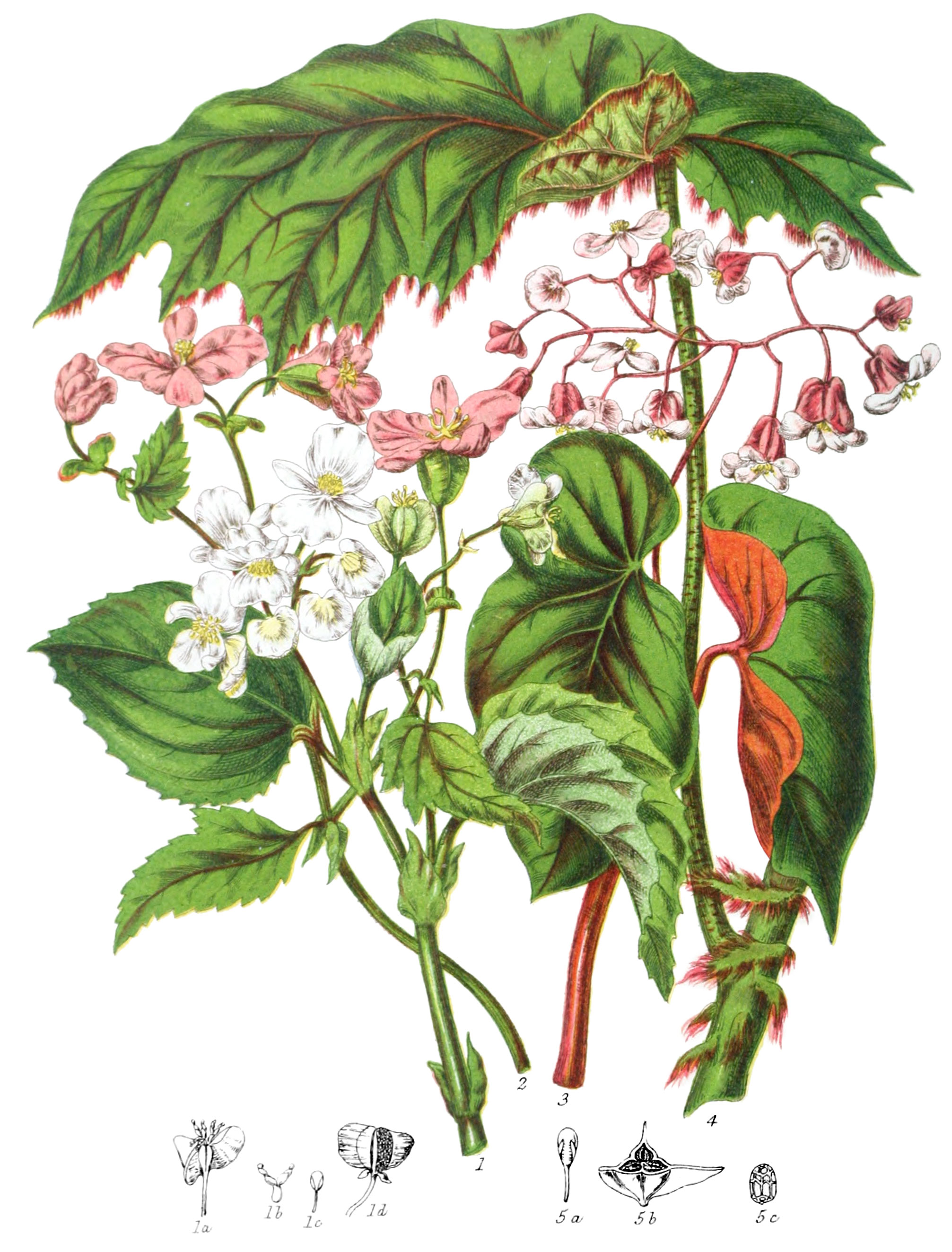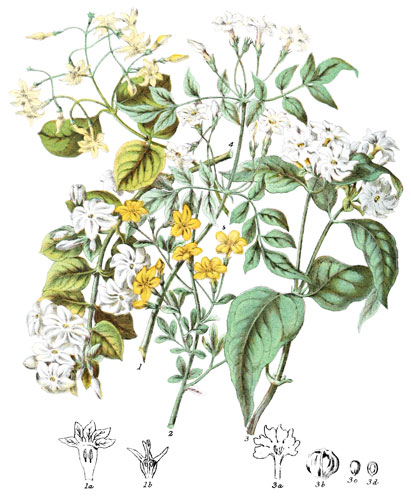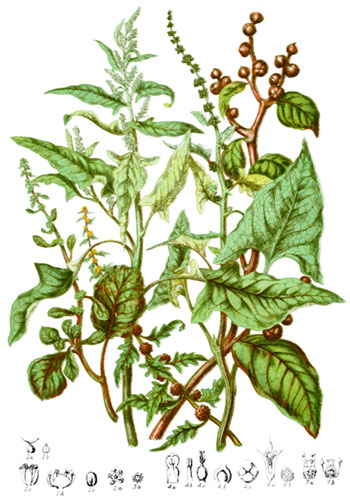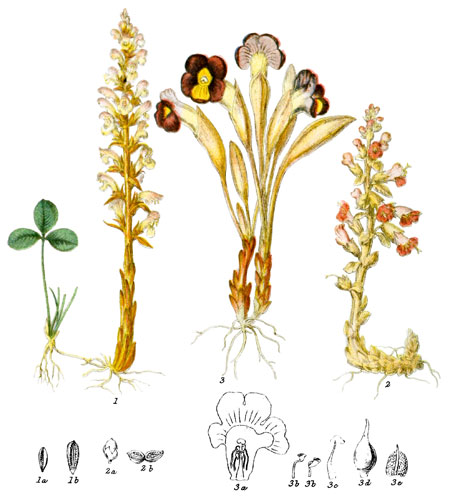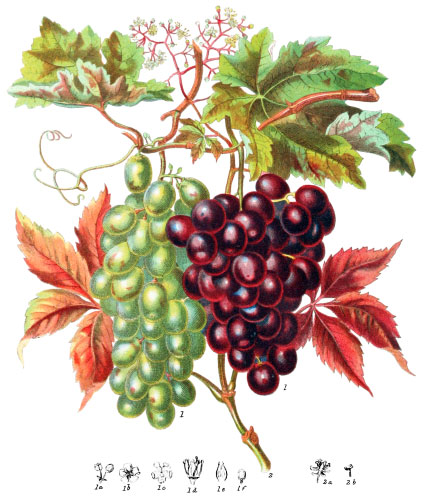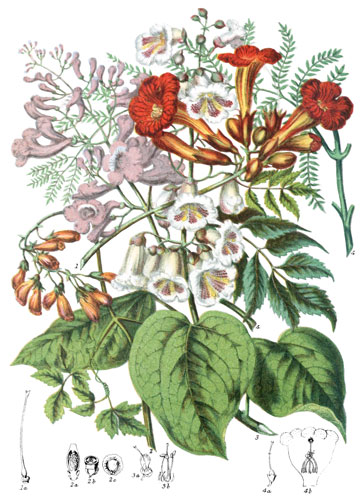Key characteristics
Succulent undershrubs, or herbaceous plants, having an acid juice. The leaves are alternate, toothed at the edges, rarely entire, usually unequal at the base. The stipules are large and membranous. The flower are pink or white; the stamens and pistils are in separate flowers on the same plant. The calyx is adherent to the ovary, coloured like a corolla; in the stamen flower the sepals are four, two, smaller, and within the other two; in the pistil flower the sepals are five, two of them smaller. The stamens are of indefinite number, either distinct, as in B. semperflorens (1), or combined into a solid column. The anthers united into a head, two-celled, continuous with the filament; the connective between the two cells of the anther remarkably large, the cells minute, bursting longitudinally. The ovary is adherent, winged, three-celled, the stigmas are three, two-lobed, placed on the ovary, and somewhat spiral. The fruit is a membranous winged capsule, three-celled, containing numerous small seeds, bursting by slits at the base of the wings. The seeds are netted, and have no albumen.
These plants have much resemblance to Polygonaceæ, in the calyx and seed-vessel.
Astringent and slightly bitter properties exist in the roots.
Select plants in this order
Not all plants listed are illustrated and not all plants illustrated are listed.
- Begonia was named after a French botanist of the 17th century; there are man species, all of a more or less succulent nature. The leaves are generally of glossy texture, and bright in colour, some very red, others covered in parts with red fringes, usually having one side much larger than the other. The flowers are curious in form, produced in great abundance throughout the summer, and very ornamental in conservatories.
- B. semperflorens (1) is a very graceful species, the delicate white flowers have the stamens with distinct filaments, and come forth plentifully in spring.
- B. diversifolia (2) is one of the brightest species of Mexico.
- B. sanguinea (3) is much admired for its singular foliage, of a tougher substance than usual, showing very remarkably the unequal sides of the base of the leaves, as well as the difference of colour between the upper and under surface. It grows to a greater height than some others, and is very beautiful.
- B. manicata (4) is an example of the fringed species, the flowers are small, but the leaves attain a large size.
- B. argyrostigma, of Brazil, is a singular species, the leaves being spotted with white; the green colouring matter not flowing in certain cells causes little rings of pure white to appear on the upper surface, a small green point remaining in the midst, the under surface of the leaf is red.
- B. discolor, of China, has mottled leaves, which make a pleasing variety.
- Although in Europe the Begonias are only esteemed for their beauty, yet in their native countries several of them are valued by the inhabitants for medicinal qualities or as food.
- The leaves of B. barbata, called tengoor, are eaten by the people who dwell in some of the valleys of the Himalaya.
- B. tuberosa and B. malabarica are also thought eatable in some parts of India.
- The root of B. grandiflora and of B. tomentosa are bitter and astringent; in Mexico several species are considered to have medicinal properties; other are employed in Peru.
- These plants require the heat and moisture of a tropical climate for their development, but some extend as far north as 30° of north latitude, finding a suitable atmosphere on the mountains of Northern India, at an elevation in some districts as high as 7000 feet, where during the rainy season in the moisture is extreme.
- B. echinata, B. picta, and B. cordata, all belong to the Himalaya.
- Eupetalum and Diploclinium are the only other genera of this tribe; the latter consists merely of those Begonias which have a double plate for the seeds in the ovary.
- The cultivation by seed is easily effected in this country. Some species have been discovered of a climbing habit, reaching to the height of twenty-five feet; this appears to form a link with Cucurbitaceæ.
Locations
These plants are very common in the East and West Indies, and in South America. None are known in Africa, but some are found in Madagascar and the Isles of France and Bourbon.
Legend
- Begonia semperflorens, White-flowered Begonia. Brazil.
- Pistils and Ovary.
- Pistil.
- Stamen.
- Capsule, showing seeds.
- Begonia diversifolia, Various-leaved Begonia. Mexico.
- Begonia sanguinea, Red-leaved Begonia. Brazil.
- Begonia manicata, Fringed Begonia. Brazil.
-
- Stamen of Diploclinium Evansianum.*
- Cross-section of the Ovary.
- Seed.
*Diploclinium was spelled “ Diplocinium” in the legend.
Explore more
Posters
Decorate your walls with colorful detailed posters based on Elizabeth Twining’s beautiful two-volume set from 1868.
Puzzles
Challenge yourself or someone else to assemble a puzzle of all 160 botanical illustrations.
